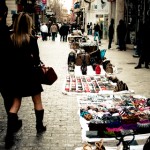For anyone who is a product entrepreneur the Internet has opened up a whole wide world of new customers who are anxious to buy your product. When I first started my business (swiggies, wrist water bottles) I never thought about selling internationally. It was overwhelming enough just selling my product in my own neighborhood. But now 90% of my business is international. The Internet has made international business more accessible for a small manufacturer, and easier to market your products globally. There are multiple ways to sell overseas with the click of a mouse.
How to market products globally
Being in the U.S. I always thought I’d manufacture my product in the U.S. But after trying it once and barely breaking even, I realized I would have to move my manufacturing to China, like most of the rest of the world. It took a few tries to find a good, honest factory, but I finally found the right one. (now I manufacture in 3 countries)
Find a middleman
Dealing with China has its own challenges, like the language barrier. This is why it’s a good idea to have someone there who can act as a middleman. Pay them a percentage. It’s worth it. They have a better understanding of the local culture and can help iron out any problems that arise. They will also be in a better position to negotiate prices for you.
Be aware of foreign holidays
I’ve found that there is a different sense of urgency there, so you want to make sure you allow plenty of time to get your merchandise. Don’t cut things too close. They also seem to have an awful lot of holidays, and some can last weeks, like Chinese New Year’s. So plan accordingly. You never know how many orders they have ahead of yours. Get your order in as early as possible to avoid delays.
Allow for time zone differences
Allow extra time for time zone differences. If you’re dealing with a distributor in South Africa and a factory in China, everyone will be in different time zones. You’ll always have a few days here and there arranging wire transfers and getting art work in. When banks are open in one country, they’re closed in another.
Factor in extra expenses
Factor in all extra expenses and adjust your prices so you don’t get the short end of the stick. I learned the hard way that an extra nickel is a lot of money when the order is 100,000 units. Make sure everything is discussed beforehand and you negotiate for the best pricing possible.
Don’t forget about taxes and duties
When quoting your customer’s prices take everything into account, like the taxes and duties they will have to pay once it gets to them and what kind of certifications you will need, if any, for their country. I always get 50% up front and 50% before they leave the port. Collecting money from a foreign country is a nightmare legal hassle. Make sure it’s all in your bank account before inventory leaves the port.
Use distributors
I’ve found the easiest way to sell internationally is through distributors. They buy in volume and basically run their own business. I just help them with marketing and publicity. They hire their own employees and do their own advertising.
A good way to get the word out about your product is by getting listed in online wholesale directories. There is also plenty of international PR that you can do to call attention to your brand.
There’s a great big world out there waiting to buy your products. They just need to know how to find you. And you need to know how to navigate the international waters.





